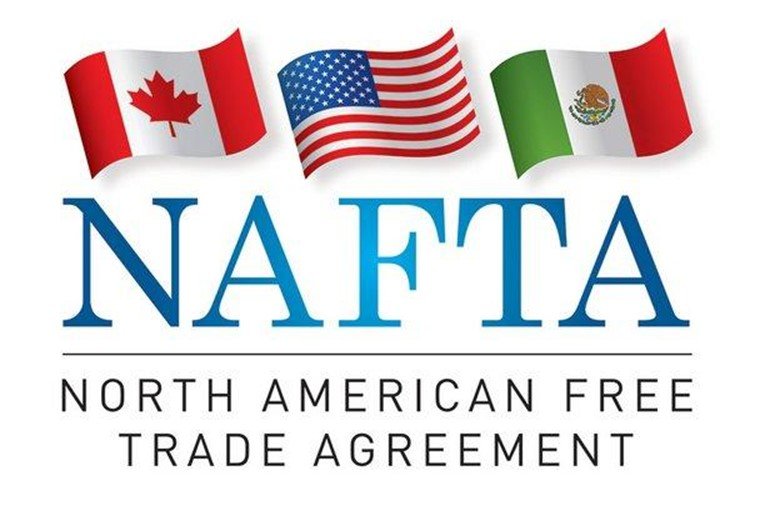NAFTA, the North American Free Trade Agreement, removed many tariffs and other barriers to trade between the U.S., Mexico and Canada. Since then, trade between the three countries has increased several times over. But not everyone has celebrated this development. Let’s take a look at the pros and cons of NAFTA.
Pros:
1. It lowered prices for many goods: Advocates of free trade generally point to lower prices for consumer goods as one of the main benefits that lowered tariffs can bring to U.S. citizens. The average American has profited from lower prices as a result of NAFTA
2. Great for the GDP: NAFTA added 0.5%, or around 80 billion dollars, to the U.S. GDP once implemented. That works out to a few extra billion dollars of GDP each year.
3. Good for diplomatic relations: It strengthens the diplomatic ties between countries. In other words, countries that are economically interconnected are less likely, the theory goes, to experience diplomatic or military conflict.
4. It increased exports: Certain sectors of the U.S. economy lost out as a result of NAFTA, but other sectors got a boost.
5. It Quadrupled trade between countries: Between 1993-2017, trade between the three members quadrupled from $297 billion to $1.17 trillion. That boosted economic growth, profits, and jobs for all three countries. It also lowered prices for consumers.
6. Lowered prices for goods: Lower tariffs also reduced import prices. That also lessened the risk of inflation and allowed the Federal Reserve to keep interest rates low.
7. It increased economic growth: NAFTA boosted U.S. economic growth by as much as 0.5 percent a year. The sectors that benefited the most were agriculture, automobiles, and services.
8. It created Jobs: NAFTA exports created five million new U.S. jobs. Most of those jobs went to 17 states, but all states saw some increases. U.S. manufacturers added more than 800,000 jobs between 1993 and 1997.
9. It increased FDI: Since NAFTA was enacted, U.S. foreign direct investment in Canada and Mexico has more than tripled. It reached $452 billion by 2012. That boosted profits for U.S. businesses by giving them more opportunities to develop, and markets to explore.
10. Reduced government spending: NAFTA allowed firms in member countries to bid on all government contracts. That created a level-playing field for all companies within the agreement’s borders.
Cons:
1. Loss of jobs: NAFTA skeptics cite the loss of U.S. manufacturing jobs as a reason to criticize NAFTA and to be wary of future trade deals. According to the CFR, the U.S. auto sector lost roughly 350,000 jobs between 1994 and 2016.
2. It hurt small farmers and business owners: Other criticisms of NAFTA look at the impact the trade deal has had on small farmers in Mexico, many of whom were unable to compete with larger agribusinesses in the wake of the agreement.
3. Suppressed wages for nob-college-educated workers: While the manufacturing sector of the U.S. economy suffered the heaviest job losses in the wake of NAFTA, wages decreased in many other sectors that don’t require workers to have a college degree.
4. Low environmental and labor standards: When the U.S. makes trade deals with middle- or low-income countries, the negotiators tend to demand higher labor, environmental and intellectual property standards than those countries previously imposed.
5. Security breaches: NAFTA means that travel in between in the countries is not as restricted. While it sounds good on paper, it opens up all of the countries to security risks, which is one of the major concerns involving travel from the United States to Mexico.
6. Exploitation of maquiladora workers: NAFTA expanded the maquiladora program by removing tariffs. That’s where U.S.-owned companies employed Mexican workers near the border. They cheaply assembled products for export back into the United States. The program grew to employ 30 percent of Mexico’s labor force. The workers had no labor rights or health protections
7. Free US access for Mexica Trucks: Another agreement within NAFTA was never implemented. NAFTA would have allowed trucks from Mexico to travel within the United States beyond the current 20-mile commercial zone limit.
8. Increased porous borders: NAFTA was supposed to bring economic prosperity to Mexico and the US especially by allowing free trade along the border. Instead, it only led to a more porous borders with more drugs being exchanged between the two countries.
9. Devaluation of the Peso: The sharp peso devaluation not only makes Mexican goods cheaper and U.S. goods more expensive in each other’s markets; it also makes Mexican labor much cheaper thereby attracting more U.S. factories to close here and go to Mexico.
10. Loss of business for small businesses: Most small and medium size companies lost business to huge corporations from both all the three countries. This led to severe job losses and subsequent closures of several companies.



